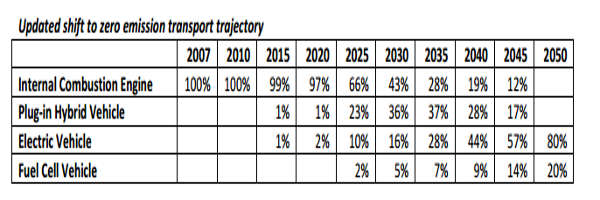The UK needs to spend more than £10bn by 2050 on public refuelling infrastructure in order to meet carbon emission targets for transport, a new report has claimed.
As part of plans to reduce greenhouse gas emissions by at least 80% by 2050, relative to 1990 levels, the government has set itself a ‘zero emissions’ plan for transport – aiming for 80% of all vehicles powered by electric and 20% using a fuel cell.
Research carried out by consultants Element Energy and published by the Low Carbon Vehicle Partnership (LCVP), concluded that ‘millions of mainly residential charge points will be needed to support widespread electric vehicle deployment’.

Image from the Department for Transport
LCVP added that ‘progress is constrained by uncertainty over future charging technologies’ and long-term policy clarity and consistent government and regulatory support would be vital.
Researchers predicted that after 2030 the petrol industry could be affected by the switch to low emissions with the ‘commercial viability of the existing forecourt network, particularly in rural locations, under pressure’.
The research sets out infrastructure road maps for different transport fuels and has contributed to an LCVP best practice guide for local authorities covering 12 areas, including planning, procurement, parking and infrastructure.
The guidance calls on councils to work together to develop a harmonised approach to encouraging low emissions vehicles rather than leaving the public with a ‘patchwork’ of different systems and policies.
Mark Constable, EDF Energy’s senior product manager - Electric Vehicles and Future Heat - said: 'EDF Energy welcome these reports and wholeheartedly supports their findings. The reports recognise the quite different stages of lifecycle development for each fuelling infrastructure. In particular, the balance between the excellent progress made for electricity by the industry and Government thus far, and the challenges that remain, is well struck.'
On hydrogen the LCVP stated: ‘Initial infrastructure investments will require financial support from government, and local government can also play a key role in providing ‘base load’ by adopting hydrogen and fuel cell vehicles in public fleets. Hydrogen demand from a range of vehicle types, from passenger cars to commercial vehicles and buses, will be needed to sustain the infrastructure during this early phase.
‘Beyond 2020, decreases in fuel cell vehicle costs and access to low cost, low carbon hydrogen is expected to allow a transition to profitable, private sector investments to build a UK-wide refuelling network and provide the same convenience to customers as petrol and diesel cars today.’
Researchers also found many opportunities for heavy vehicles to use natural gas supported by mature refuelling technologies but added that ‘regulatory barriers need to be addressed’.
Richard Cook, National Grid’s Design Manager - Network Design, said: 'We believe that the use of methane (natural gas) as a fuel in the transport sector can play a significant role in reducing greenhouse gas emissions. Whether it’s compressed natural gas (CNG) or liquefied natural gas (LNG), the benefits for use as a fuel in HGVs and buses are clear; lower emissions, quieter engine noise and favourable fuel prices, compared with traditional liquid fuels.'